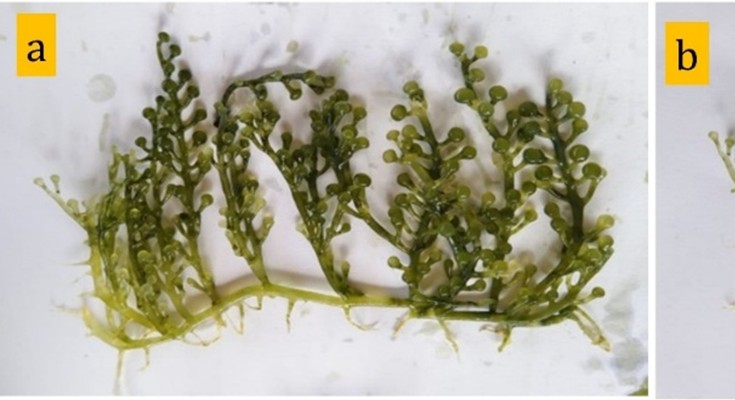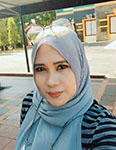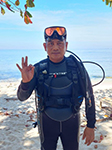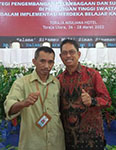Akuatikisle: Jurnal Akuakultur, Pesisir dan Pulau-Pulau Kecil
Full Length Article
Identification of sea grape (Caulerpa racemosa) content using X-Ray Fluorescence (XRF) spectrometer
Highlights
Generate NLP AI by Wizdam ID.
Abstract
Seaweed possesses the potential to serve as a functional food or supplement, being nutrient-dense and a source of food and medicine due to its abundance of minerals, vitamins, and antioxidants. In Indonesia, seaweed is extensively utilized due to its advantageous properties for multiple industries, including agriculture, animal husbandry, pharmaceuticals, chemicals, and medicine. This study seeks to discover a specific component of sea grape (Caulerpa racemosa), which is prevalent in the waters of Lohia Village, Lohia District, Muna Regency, Southeast Sulawesi. The composition of sea grape (Caulerpa racemosa) was analyzed utilizing an X-ray Fluorescence Spectrometer (XRF) due to its capacity to detect nearly all minerals in a single measurement. The study's findings indicated that sea grapes (Caulerpa racemosa) at stations 1, 2, and 3 contained Chlorine (Cl), Calcium (Ca), Potassium (K), and Bromine (Br), along with several trace elements including Iron (Fe), Phosphorus (P), Strontium (Sr), Silicon (Si), and Titanium (Ti) in minor quantities. At stations 4, 5, and 6, sea grapes (Caulerpa racemosa) predominantly exhibited Chlorine (Cl), Potassium (K), and Magnesium (Mg), whereas Calcium (Ca) and Bromine (Br) were present in lesser quantities. Despite the considerable benefits of sea grapes (Caulerpa racemosa) for humans, caution is imperative in their use. Sea grapes (Caulerpa racemosa) possess the capacity to absorb minerals and bioaccumulate heavy metals from seawater, resulting in the presence of trace elements.
Keywords
Introduction
Section snippets
Material and Methods
Materials and methods from the full-text PDF of this article cannot be displayed.
Results
Results from the full-text PDF of this article cannot be displayed.
Discussion
Discussion from the full-text PDF of this article cannot be displayed.
Conclusions
Conclusions from the full-text PDF of this article cannot be displayed.
Acknowledgment
Acknowledgment from the full-text PDF of this article cannot be displayed.
Competing interest
The authors declare that they have no known competing financial interests or personal relationships that could have appeared to influence the work reported in this paper.
Conflict of interest
The authors declare that the research was conducted in the absence of any commercial or financial relationships that could be construed as a potential conflict of interest.
Ethical approval acknowledgements
No ethical approval required for this article. All procedures followed were in accordance with the ethical standards of the responsible committee on human experimentation (institutional and national) and with the Helsinki Declaration of 1975, as revised in 2008 (5)
Supplementary files
Data sharing not applicable to this article as no datasets were generated or analysed during the current study, and/or contains supplementary material, which is available to authorized users.
References (31)
Brito, G. B.; Teixeira, L. S. G. & Korn, M. G. A., 2017. Direct analysis of marine macroalgae for determination of macro minerals by energy dispersive X-ray fluorescence. Microchemical Journal, 134: 35–40, ISSN: 0026-265X, DOI: https://doi.org/10.1016/j.microc.2017.05.001, Available: .
Bull, A.; Brown, M. T. & Turner, A., 2017. Novel use of field-portable-XRF for the direct analysis of trace elements in marine macroalgae. Environmental Pollution, 220: 228–233, ISSN: 0269-7491, DOI: https://doi.org/10.1016/j.envpol.2016.09.049, Available: .
Dewi, R., 2012. Potensi Sumberdaya Rumput Laut. Jurnal Harpodon Borneo, 5(2): 125–129.
Erniati; Erlangga; Andika, Y. & Muliani, 2023. Seaweed diversity and community structure on the west coast of Aceh, Indonesia. Biodiversitas, 24(4): 2189–2200, ISSN: 20854722, DOI: 10.13057/biodiv/d240431.
Hasan, A., 2006. Dampak penggunaan klorin. Jurnal Teknologi Lingkungan, 7(1), ISSN: 2548-6101.
Indriyani, R. & Sumardilah, D. S., 2020. Efek Formula Daun Bayam dan Rumput Laut Meningkatkan Kandungan Kalsium dalam Produk Nori yang Disukai. Jurnal Kesehatan Metro Sai Wawai, 13(1): 1–10, ISSN: 2657-1390.
Kasmiati, K.; Syahrul, S.; Badraeni, B. & Rahmi, M. H., 2022. Proximate and mineral compositions of the green seaweeds Caulerpa lentilifera and Caulerpa racemosa from South Sulawesi Coast, Indonesia. IOP Conference Series: Earth and Environmental Science, 1119(1), ISSN: 17551315, DOI: 10.1088/1755-1315/1119/1/012049.
Kusumaningrum, I. & Rahayu, N. S., 2018. Formulasi Snack Bar Tinggi Kalium Dan Inggi Serat Berbahan Dasar Rumput Laut, Pisang Kepok, Dan Mocaf Sebagai Snack Alternatif Bagi Penderita Hipertensi. Argipa, 3(2): 102–110.
Laili, R. D.; Ethasari, R. K. & Saidah, Q. I., 2023. Analisis Kandungan Zat Besi dan Kalsium Pada Biskuit dengan Penambahan Tepung Rumput Laut (Eucheuma cottonii). AGRITEKNO: Jurnal Teknologi Pertanian, 12(2): 98–105, ISSN: 2620-9721.
Laily, W. N.; Izzati, M. & Haryanti, S., 2019. Kandungan mineral dan logam berat pada garam yang diekstrak dari rumput laut Sargassum sp. menggunakan metode dibilas dan direndam. Jurnal Pro-Life, 6(3): 274–285.
Litaay, C.; Arfah, H. & Pattipeilohy, F., 2022. Potensi Sumber Daya Hayati Rumput Laut di Pantai Pulau Ambon sebagai Bahan Makanan: The Potential of Seaweed Resources on the Coastal of Ambon Island as Food Ingredient. Jurnal Pengolahan Hasil Perikanan Indonesia, 25(3 SE-Articles): 405–417, DOI: 10.17844/jphpi.v25i3.41647, Available: .
Lomartire, S.; Marques, J. C. & Gonçalves, A. M. M., 2021. An Overview to the Health Benefits of Seaweeds Consumption. Marine drugs, 19(6), Switzerland, ISSN: 1660-3397 (Electronic), DOI: 10.3390/md19060341.
M. Irfan; Samadan, G. M.; Malan, S. & Subur, R., 2021. The trials of seaweed Caulerpa racemosa cultivation using the off-bottom culture at The Kastela Waters, Ternate Island Districht, Ternate City. Agrikan: Jurnal Agribisnis Perikanan, 14(1): 80–83, ISSN: 1979-6072, DOI: 10.29239/j.agrikan.14.1.80-83.
Madusari, B. D. & Wibowo, D. E., 2018. Potensi dan peluang Produk Halal Berbasis Rumput Laut. Indonesia Journal of Halal, 1(1): 53–57, ISSN: 2656-4963.
Magdugo, R. P.; Terme, N.; Lang, M.; Pliego-Cortés, H.; Marty, C.; Hurtado, A. Q.; Bedoux, G. & Bourgougnon, N., 2020. An Analysis of the Nutritional and Health Values of Caulerpa racemosa (Forsskål) and Ulva fasciata (Delile)-Two Chlorophyta Collected from the Philippines. Molecules (Basel, Switzerland), 25(12), Switzerland, ISSN: 1420-3049 (Electronic), DOI: 10.3390/molecules25122901.
Manggara, A. B. & Shofi, M., 2018. Analisis kandungan mineral daun kelor (Moringa oleifera Lamk.) menggunakan spektrometer XRF (X-Ray Fluorescence). Akta Kimia Indonesia, 3(1): 104–111, ISSN: 2549-3736.
Merdekawati, W. & Susanto, A. B., 2009. Kandungan Dan Komposisi Pigmen Rumput Laut Serta Potensinya Untuk Kesehatan. Squalen Bulletin of Marine and Fisheries Postharvest and Biotechnology, 4(2): 41, ISSN: 2089-5690, DOI: 10.15578/squalen.v4i2.147.
Milinovic, J.; Figueiredo, F. M. J.; Noronha, J. P. & Sardinha, J., 2022. Application of ED-XRF spectra for determination of macroelements in edible seaweeds. Journal of Food Composition and Analysis, 110: 104559, ISSN: 0889-1575, DOI: https://doi.org/10.1016/j.jfca.2022.104559, Available: .
Papalia, S., 2015. Struktur Komunitas Makro Alga Di Pesisir Pulau Haruku, Kabupaten Maluku Tengah Community Structure of Seaweed At Coastal Area of Haruku Island, Central Mollucas Province. Jurnal Ilmu dan Teknologi Kelautan Tropis, 7(1): 129–142, Available: .
Potts, P. J. & Webb, P. C., 1992. X-ray fluorescence spectrometry. Journal of Geochemical Exploration, 44(1): 251–296, ISSN: 0375-6742, DOI: https://doi.org/10.1016/0375-6742(92)90052-A, Available: .
Raza’i, T. S.; Thamrin; Nofrizal; Amrifo, V.; Pardi, H.; Pangestiansyah Putra, I.; Febrianto, T. & Fadhli Ilhamdy, A., 2021. Accumulation of essential (copper, iron, zinc) and non-essential (lead, cadmium) heavy metals in Caulerpa racemosa, sea water, and marine sediments of Bintan Island, Indonesia. F1000Research, 10: 699, England, ISSN: 2046-1402 (Electronic), DOI: 10.12688/f1000research.54445.2.
Riska, N.; Suedy, S. W. A. & Izzati, M., 2019. Kandungan Mineral dan Logam Berat pada Biosalt Rumput Laut Padina sp. Jurnal Pro-Life, 6(2): 171–179, ISSN: 2579-7557.
Romarís-Hortas, V.; Bermejo-Barrera, P.; Moreda-Piñeiro, J. & Moreda-Piñeiro, A., 2012. Speciation of the bio-available iodine and bromine forms in edible seaweed by high performance liquid chromatography hyphenated with inductively coupled plasma-mass spectrometry. Analytica Chimica Acta, 745: 24–32, ISSN: 0003-2670, DOI: https://doi.org/10.1016/j.aca.2012.07.035, Available: .
Rosnawati, R.; Cokrowati, N. & Diniarti, N., 2022. Response of Light Intensity to The Carotenoid Content of Sea Grape Caulerpa sp. Jurnal Natur Indonesia, 20(2): 41, ISSN: 1410-9379, DOI: 10.31258/jnat.20.2.41-49.
Sanger, G.; Kaseger, B. E.; Rarung, L. K. & Damongilala, L., 2018. Potensi beberapa Jenis Rumput Laut sebagai Bahan Pangan Fungsional, Sumber Pigmen dan Antioksidan Alami. Jurnal Pengolahan Hasil Perikanan Indonesia, 21(2 SE-Articles): 208–217, DOI: 10.17844/jphpi.v21i2.22841, Available: .
Sofiana, M. S. J.; Mardini, D. D.; Safitri, I.; Warsidah, W. & Nurdiansyah, S. I., 2024. Kandungan nutrien dan fitohormon rumput laut cokelat dari Perairan Pulau Lemukutan Kalimantan Barat: Nutrient and phytohormone of Sargassum polycystum and Padina australis from Lemukutan Island Waters West Kalimantan. Jurnal Pengolahan Hasil Perikanan Indonesia, 27(4 SE-Articles): 327–336, DOI: 10.17844/jphpi.v27i4.46965, Available: .
Suparmi, S. & Sahri, A., 2009. Mengenal Potensi Rumput Laut : Kajian Pemanfaatan Sumber Daya Rumput Laut dari Aspek Industri dan Kesehatan. Majalah Ilmiah Sultan Agung, 44(118): 95–116, ISSN: 2252-729X.
Verlaque, M.; Durand, C.; Huisman, J. M.; Boudouresque, C.-F. & Le Parco, Y., 2003. On the identity and origin of the Mediterranean invasive Caulerpa racemosa (Caulerpales, Chlorophyta). European Journal of Phycology, 38(4): 325–339, ISSN: 0967-0262.
Yangthong, M., 2009. Antioxidant Activities of Four Edible Seaweeds from the Southern Coast of Thailand. : 218–223, DOI: 10.1007/s11130-009-0127-y.
Yoga, W. K. & Komalasari, H., 2022. Potensi Alga Hijau (Caulerpa Racemosa) Sebagai Sumber Antioksidan Alami. Jurnal Teknologi dan Mutu Pangan, 1(1): 16–20, ISSN: 2962-7826.
Yudasmara, G. A., 2015. Budidaya Anggur Laut (Caulerpa Racemosa) melalui Media Tanam Rigid Quadrant Nets Berbahan Bambu. JST (Jurnal Sains dan Teknologi), 3(2), ISSN: 2303-3142, DOI: 10.23887/jst-undiksha.v3i2.4481.
Bibliographic Information
Cite this article as:
-
Submitted
27 March 2025 -
Accepted
25 July 2025 -
Published
28 July 2025 -
Version of record
9 September 2025 -
Issue date
30 November 2025
-
Academic subject
Aquaculture; Fisheries Sciences
Copyright
Sangia Advertisement
Copyright © 2025 Dewi Susilawati, Fendi, Rochmady, Abdul Rakhfid, Mosriula. Sangia Research Media and Publishing. Production and hosting by Sangia (SRM™).  This work is licensed under a Creative Commons Attribution-ShareAlike 4.0 International License.
This work is licensed under a Creative Commons Attribution-ShareAlike 4.0 International License.
Disclaimer: All claims expressed in this article are solely those of the authors and do not necessarily represent those of their affiliated organizations, or those of the publisher, the editors and the reviewers. Any product that may be evaluated in this article or claim that may be made by its manufacturer is not guaranteed or endorsed by the publisher.
Comments on this article
By submitting a comment you agree to abide by our Terms and Community Guidelines. If you find something abusive or that does not comply with our terms or guidelines please flag it as inappropriate.












